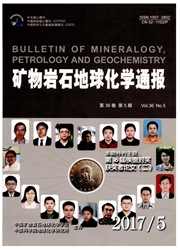

 中文摘要:
中文摘要:
锰氧化物是常见的半导体材料之一,本文利用XRD、Raman、X射线吸收-发射谱及Zeta电位测试技术对合成的4种锰氧化物矿物(酸性水钠锰矿、碱性水钠锰矿、δ-MnO_2、锰钾矿)的能带结构进行了理论计算。结果表明,4种矿物均是可见光响应的半导体矿物,其禁带宽度分别为2.32 eV、1.77 eV、1.36 eV、1.23 eV;在p H等于6时,4种锰氧化物矿物对应的导带电势分别为-0.32 V、0.09 V、0.39 V、0.46 V(vs.NHE),价带电势分别为2.00 V、1.86 V、1.75 V、1.69 V(vs.NHE)。与腐殖质氧化还原电势相比较,4种锰氧化物矿物在任何pH条件下均能吸收可见光催化氧化腐殖质。从结构上比较,层状结构比隧道结构的锰氧化物可见光催化氧化还原能力更强。
 英文摘要:
英文摘要:
Mn oxides are common semiconductor materials. In this work,based on the data obtained from X-ray diffraction,Raman scattering,X-ray absorption and emission spectra and zeta potential measurements,we calculated the band structure of Hex-Birnessite,Mon-Birnessite,δ-MnO_2 and Cryptomelane. The experiment results indicated the bandgaps of these Mn oxides are 2. 32 eV,1. 77 eV,1. 36 eV and 1. 23 eV,respectively. The calculated conduction band edges are-0. 32 V,0. 09 V,0. 39 V,0. 46 V,respectively,with valence band edges at p H = 6 are 2. 00 V,1. 86 V,1. 75 V,1. 69 V,respectively. All of the four Mn oxides have higher potential than humic acid so that all Mn oxides can oxidize humic acid at any p H values. Overall,the photocatalytic redox capability of layered Mn oxides were higher than that of tunnel-structure Mn oxides.
 同期刊论文项目
同期刊论文项目
 同项目期刊论文
同项目期刊论文
 期刊信息
期刊信息
